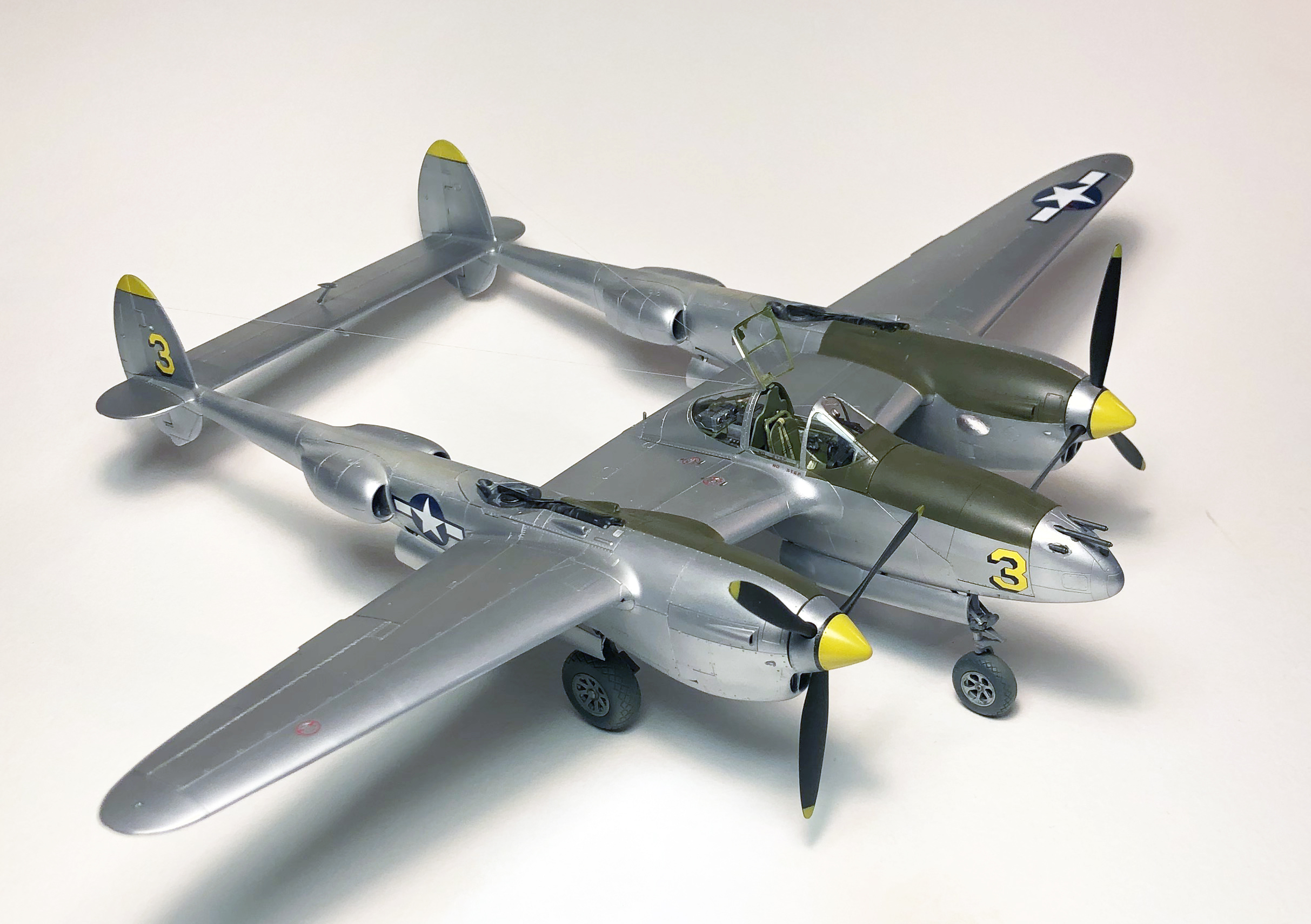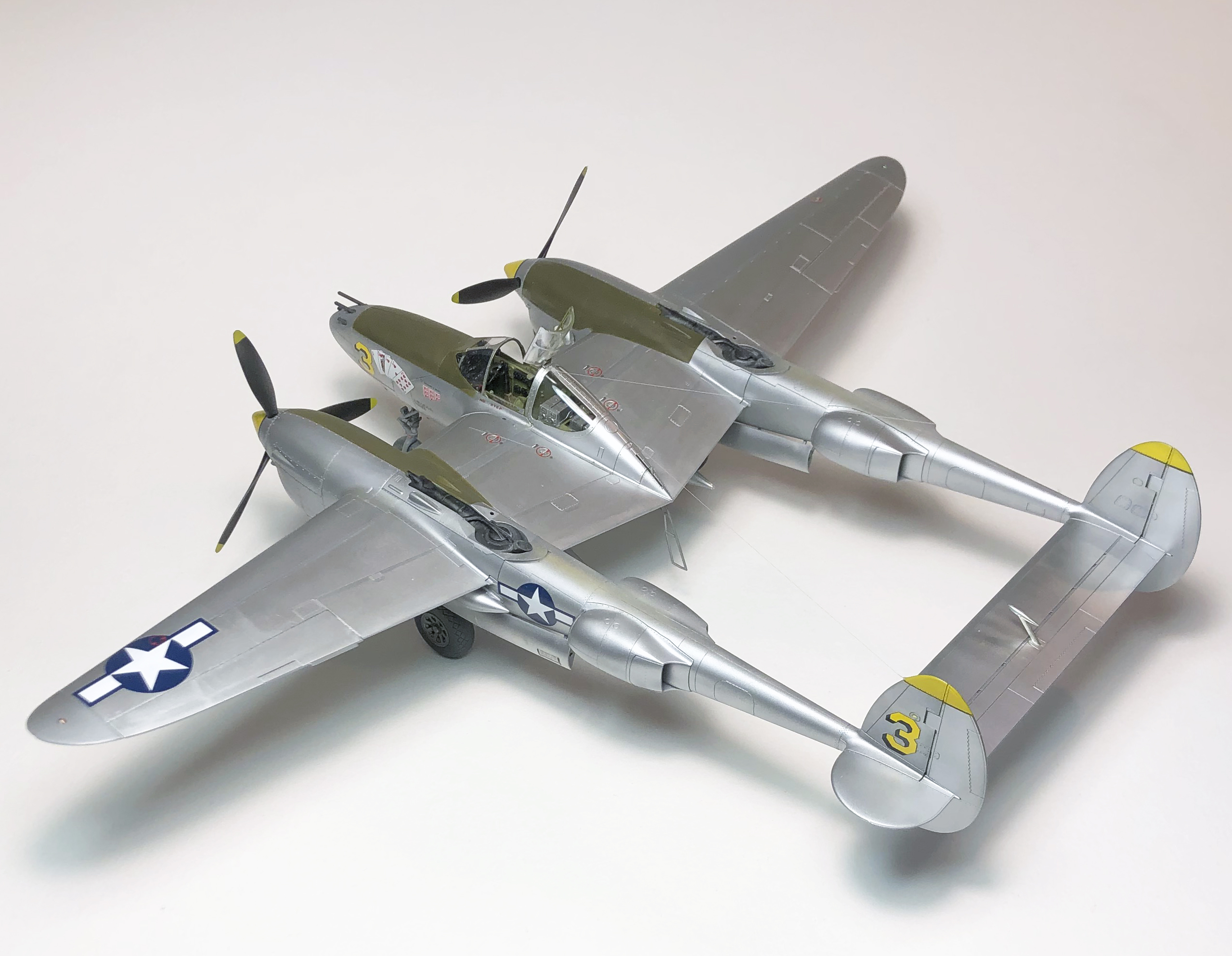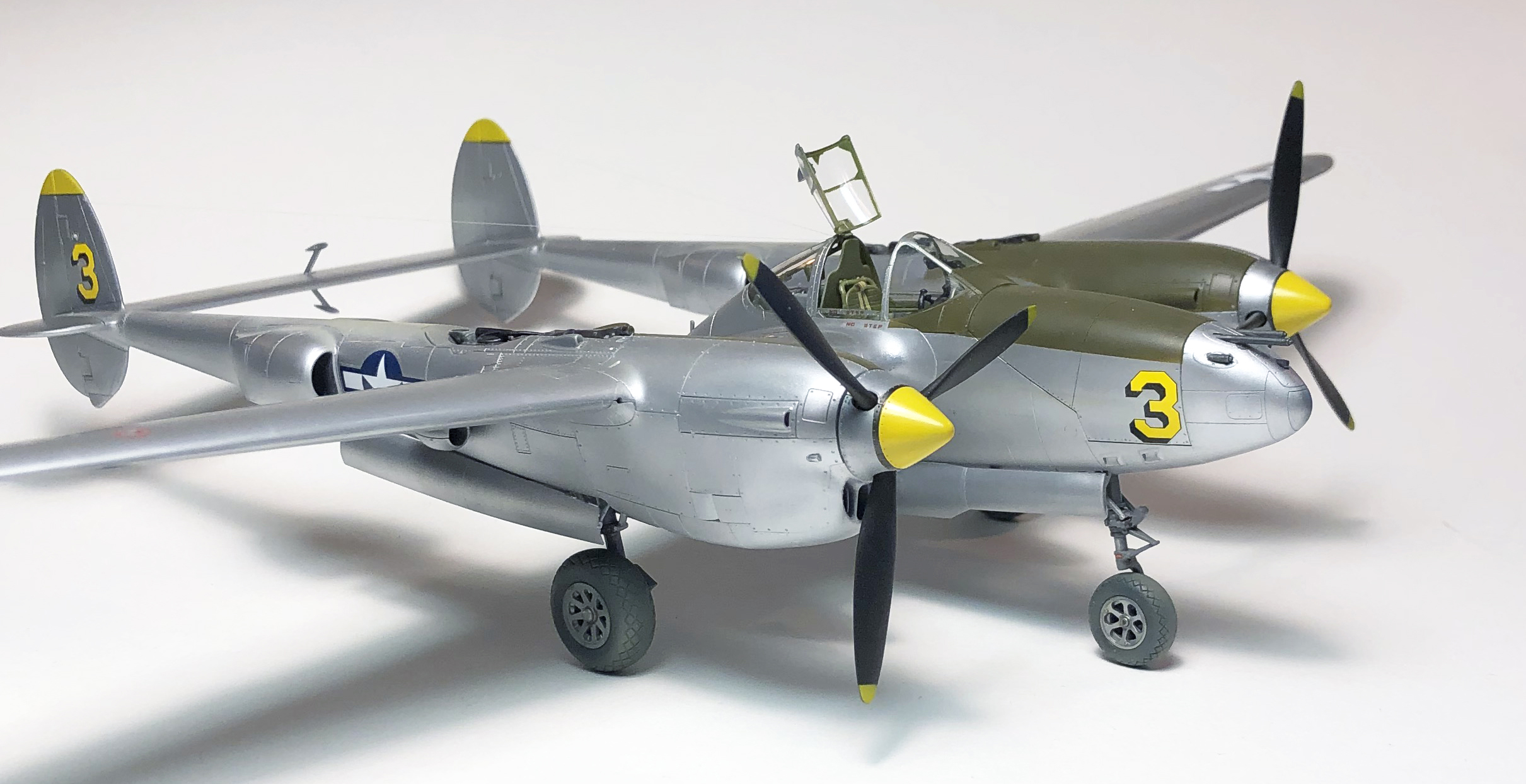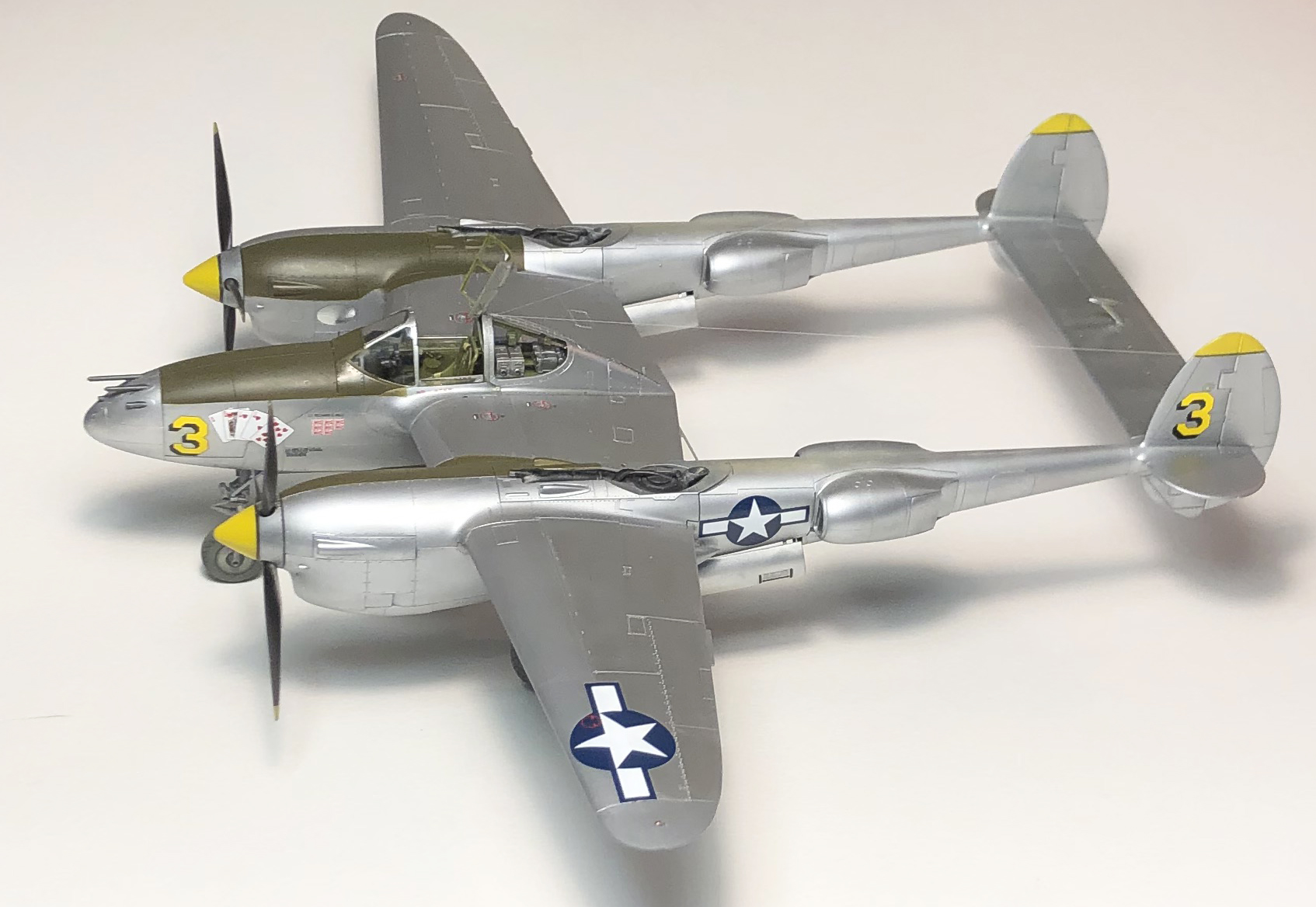Tamiya P-38J-15 Lightning, 1-48th Scale
By Phillip Friddell on 28th Jun 2022
It seems as though it was only yesterday that Tamiya released their much-anticipated P-38F/G kit to an eager polystyrene world, although it's actually been a couple of years since then. That kit was widely received as among the best available of any Second World War aircraft subject and was quickly followed by the issuance of a P-38H, a lesser-known yet highly significant member of the Lightning family. That pair of kits neatly captured the early P-38 market but, as is so often the case, we all wanted more! Specifically we wanted the final operational aircraft, the P-38J and L, so we could model all those spiffy late-war schemes worn by the airplane. Everyone knew, of course, that Tamiya would scratch that particular itch sooner or later but the question was when; early July saw the answer.
Tamiya's first late-war P-38, kit number 61123, has finally been released. It's a P-38J-15, a common variant used by a number of high-scoring SWPAC aces, and it's a dandy of a kit.

Sometimes reviews can almost write themselves, and this is one of those times. If you've already built the P-38F/G/H from this manufacturer you know how good the basic kit is. This iteration, the first of what we hope to be a two-variant family, is more of the same. Several of the sprues are identical with those early P-38s although the appropriate changes have been made to properly cater for the construction of a late Lightning.
So what do you get when you open the box of your brand-new P-38J? For starters, everything is crisply molded, with crystal-clear transparencies and beautifully-defined detail. There's a super pilot figure in there too, if you like to use that sort of thing, and the now-ubiquitous set of ballast balls (probably ball bearings, truth be known, but let's give them a semi-fancy name for the purpose of this review). The usual instructions are there, of course, along with two large, full color foldouts illustrating the trio of aircraft that can be modeled using the kit decals.

Optional parts are limited to the auxiliary fuel tanks that can be placed under the wings and the ability to show the pilot's boarding ladder either deployed or stowed, plus two different sets of guns. No bombs are provided, and the P-38 often flew fighter-bomber missions late in the war so their inclusion would have been appreciated, but that's an easy fix should you be inclined to configure your model that way. Caps are provided for the wing pylons if your preference is a clean airplane with no underwing tanks, and it's worth remembering that not all missions were flown with a "standard" underwing tank configuration since their use on the airplane was married to the mission at hand. It's possible to see one tank, two tanks, or no tanks at all on the airplane depending on the presumed range requirements of each particular sortie. You might also note that the use of the 300-gallon tanks provided with the kit (those are the larger of the two) was limited in the SWPAC. The smaller 150-gallon tanks were far more apparent within the theater.

Kit markings cater to the Japanese home market and include three airplanes: Dick Bong's 42-103993 as assigned to 5th AF Fighter Command and replete with red trim and a beautifully rendered "Marge" photo for the nose. (Note that that particular bit of decoration truly was a photograph stuck to the nose and wasn't always on the airplane!)
Charles McDonalds 42-104024 "Putt Putt Maru" from his time as 475th FG CO is included as well, and the kit offerings are topped with decals for "Pudgy III" as applied to his airplane while commanding the 431st FS/475th FG during 1944. The aftermarket will likely see a number of P-38J sheets in the near future, should your tastes run to other airplanes or to different theaters of operations. On a personal level we weren't particularly interested in any of the kit markings and chose instead to model Dick West's airplane while he was assigned to the 35th FS/8th FG at Owi during 1944 but that was solely because of the markings. The actual quality of the kit's decals is easily as good as any aftermarket and they can be used without reservation.
While we're discussing decals, mention should be made of Tamiya's attempt at duplicating the airplane's seat belts and shoulder harnesses with waterslide decals. They actually looked ok on their backing paper so we applied them, confident in the knowledge that we'd shortly be pulling them off to replace them with photoetch, but that's not how things worked out. No; they aren't three dimensional, but they look just fine in that cockpit and are still there on the review sample. Some folks will certainly prefer to pop for a set of aftermarket belts but there's honestly no reason to do that. The kit belts are just fine, with the caveat that careful application to get an appropriate "drape" over the seat is required.
Nothing's perfect, of course, and there are a couple of minor glitches in the kit that you should be aware of.
Two of the "problems", and we use that term extremely loosely, have to do with paint application on the basic airframe, and both are extremely easy to deal with should you choose to do that. First up is the finish inside the landing gear bays and on the landing gear struts; Tamiya would have you paint them all silver. That's accurate for a P-38L but not for a J. The J's wheel wells were largely painted in Neutral Grey, with a couple of unpainted stainless steel panels inside.
The landing gear struts were Neutral Grey on this variant.
Of more obvious concern (but not really) is the exterior finish of those P-38s finished in natural metal. They were finished at the factory in a manner extremely similar to the way wartime P-51Ds were finished, with some areas in polished natural aluminum and others puttied and painted with silver lacquer. You can see a little bit of that in the first photograph of our model included with this review, although it must be stated that the differences can literally disappear depending on the lighting the model is being viewed in. It was a worthwhile treatment for us, but it may not be for you.
More importantly, but in one of those You Can't See It So What Does It Really Matter kind of ways to some people, at least, this kit omits any mention of the filters that lived within the main landing gear wells, there to prevent dust from entering and destroying the airplane's engines. They were installed on most if not all operational P-38s and would definitely have been present on any Lightning flying in the SWPAC. They're actually provided in the kit, part numbers C11/C12/C13 and C14, but they aren't identified for use and don't appear on the instruction sheet. It's an easy matter to install them and an odd omission on Tamiya's part. Fortunately it's an error that's easily rectified, as well as one that can't be seen unless you turn the model upside-down to view it. They're there, inside the wheel wells on this model, for whatever that's worth...

At the end of the day, and in spite of those exceedingly minor glitches we've just discussed, the scale modeling community has been given quite a model by the folks at Tamiya, and it appears that we still have one more variant to go since the decal sheet provided for the kit's stencils is labeled "P-38J/L" in tiny lettering. An L-model would allow us to duplicate all that bawdy nose art so prevalent in the Philippines and on Ie Shima during late 1944 and early 1945, and would neatly tie up Tamiya's P-38 family so we truly hope they do it, and sooner rather than later, but we'd be happy were this to end up being the only late P-38 they offered. It's yet another Tamiya wunderkit!
It's almost impossible to review this model without appearing to be on Tamiya's payroll, but it truly is a marvel. Detail is exceptional, kit dimensions are more than adequate, and component fit is superb---if something doesn't fit on this model you probably need to take a step back and see what you're doing wrong because the problem doesn't lie with the kit! The decals are exceptional, albeit limited to one particular group of pilots in one specific theater of war, and the overall package sets the bar just that much higher than before. All we can say is Thank you, Tamiya. May we have another?

